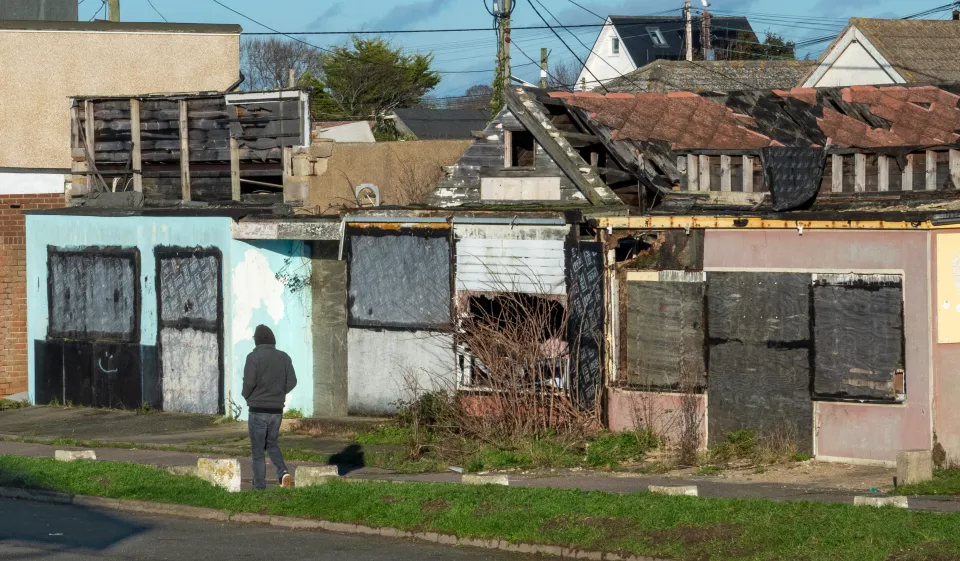For the fifth consecutive year, the coastal village of Jaywick in Essex has been named the most deprived area in England, according to the latest government data. The findings, published as part of the 2025 Index of Multiple Deprivation, reveal a sobering picture of inequality, with several coastal and northern communities continuing to face severe social and economic challenges despite national growth and falling unemployment elsewhere in the country.
Jaywick, a small settlement on the outskirts of Clacton-on-Sea, has long symbolised the enduring gap between the UK’s affluent and deprived regions. Once envisioned as a cheerful seaside retreat in the early 20th century, the village has struggled for decades with chronic poverty, poor housing, and limited access to services — issues that persist even as regeneration efforts continue.
A Community Trapped by Decline
Driving through Jaywick today, it’s hard to imagine that the area was once a holiday haven for working-class Londoners seeking escape from the city. Rows of small chalets — many built as temporary summer homes — still line the streets, some in disrepair, others modified into year-round residences. For many residents, however, life here is far from idyllic.
According to the government’s report, Jaywick ranks worst in England for multiple factors including income, employment, health, and living environment. Nearly 45% of its working-age residents are either unemployed or economically inactive, while local healthcare facilities remain overstretched. The nearest full-service hospital is over 12 miles away, and public transport connections to nearby towns are limited.
One resident, 58-year-old Kevin Turner, described life in Jaywick as “a fight to get by.” “There’s not much here in terms of work,” he said. “Most people rely on seasonal jobs or benefits. You try your best, but the opportunities just aren’t here.”
Government Promises, Little Progress
Successive governments have pledged to tackle deprivation in Jaywick, launching regeneration projects aimed at improving housing, boosting job prospects, and revitalising the local economy. Yet despite millions of pounds in funding, progress has been painfully slow.
In 2019, Tendring District Council received nearly £5 million through the Coastal Community Fund, followed by further investment from the Levelling Up initiative. Some improvements have been made — new flood defences, road repairs, and small business grants — but locals say these efforts have barely scratched the surface.
Councillor Mary Newton of Tendring District Council acknowledged the frustrations: “We’re doing what we can, but Jaywick’s challenges are deeply rooted. It’s not just about money — it’s about long-term planning, education, healthcare access, and infrastructure.”
Critics argue that the government’s “levelling up” agenda has failed to deliver meaningful change in England’s poorest areas. “The policy has produced headlines, but not results,” said Dr. Louise Hargreaves, an urban policy expert at the University of Essex. “Communities like Jaywick are stuck in a cycle of poverty because the investment doesn’t match the scale of the problem.”
The Wider Picture: Coastal and Northern Hardship
Jaywick’s situation is far from unique. The report identifies several other areas that remain entrenched in deprivation, including Blackpool, Middlesbrough, and parts of Liverpool, Hull, and Manchester. Many of these regions share similar patterns: declining industries, aging populations, and weak transport links to larger economic centres.
Blackpool, for instance, was once a thriving seaside resort but now struggles with high unemployment, substandard housing, and some of the worst health outcomes in the country. The town’s life expectancy rates are among the lowest in the UK, while rates of mental illness and substance abuse remain stubbornly high.
Experts say these areas suffer from “geographic poverty traps” — communities that are physically and economically isolated, making it difficult for residents to access jobs, education, or affordable housing. “It’s a vicious circle,” said Hargreaves. “When young people leave for better opportunities, it leaves behind an aging population with declining public services. The cycle then repeats.”
The Human Cost
Behind the statistics are real lives marked by hardship and resilience. In Jaywick, families describe daily struggles with damp housing, limited job prospects, and social stigma. “People look down on us,” said single mother Claire Mason, 32, who has lived in the area for over a decade. “But we’re just trying to survive. There’s a strong community spirit here — people look after each other when no one else does.”
That sense of solidarity is evident in grassroots initiatives across the village. Local food banks, volunteer-run libraries, and community clean-up efforts have become vital lifelines. “Jaywick is full of people who care,” said local volunteer Steve Brooks. “We might not have much, but we help each other.”
Calls for a New Approach
The findings have renewed calls for a radical rethink in how the government addresses regional inequality. Economists and campaigners argue that short-term funding projects are not enough to reverse decades of underinvestment.
“The data confirms what we already know — deprivation is structural,” said Labour MP for Clacton, Charlotte Ford. “We need sustained investment in affordable housing, skills training, and health infrastructure. Communities like Jaywick can’t be transformed by one-off grants.”
The Department for Levelling Up, Housing and Communities responded by reaffirming its commitment to tackling inequality, citing ongoing investments in education, public transport, and green jobs. A spokesperson stated, “We remain determined to ensure every community across the UK has the tools it needs to thrive. Work is already underway in many of these areas to boost opportunity and improve living standards.”
A Glimmer of Hope
Despite the grim statistics, there are signs of optimism. A handful of small businesses and social enterprises have begun setting up in Jaywick, offering training programs and creating jobs in construction and tourism. The local council is also exploring plans for a new enterprise hub designed to support entrepreneurs and attract investment.
In addition, a growing number of young residents are using social media to challenge negative perceptions of their community. “Jaywick isn’t just what people see in the tabloids,” said 24-year-old photographer Mia Roberts. “There’s beauty here, and people with big hearts. We just need a fair chance.”
The Road Ahead
As England grapples with economic uncertainty and post-pandemic recovery, the plight of towns like Jaywick stands as a stark reminder that progress is not evenly shared. While major cities such as London, Manchester, and Bristol continue to thrive, smaller communities on the periphery risk being left behind.
Sociologists warn that ignoring these disparities could deepen social divisions and fuel resentment. “Deprivation isn’t just an economic issue — it’s a moral one,” said Dr. Hargreaves. “When we allow whole regions to stagnate, we undermine the fabric of the nation.”
For Jaywick’s residents, the hope remains simple yet profound — that someday, their community will be known not for its deprivation, but for its resilience and rebirth. Until then, they continue to face each day with quiet determination, holding on to the belief that change, however slow, is still possible.



